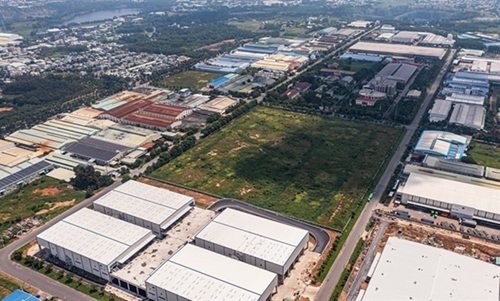In the first quarter of 2023, the industrial park real estate market recorded a slow growth in the eligible land fund for rent, up 2.1% over the end of 2022. The gain came from the addition of land for lease from industrial zones in Long An, Bac Ninh, and Hai Duong provinces.
    |
 |
|
Tan Dong Hiep B Industrial Park in Di An city, Binh Duong province |
Phan Van Mai, Chairman of the Ho Chi Minh City People's Committee, said at a meeting in late April that the city also lacks industrial land for leasing to draw sizable projects and sizable investors for new companies.
The shortage of industrial land funds is happening in Dong Nai province, limiting FDI capital. The province is no longer in the Top 5 localities attracting the most FDI inflows in the country, according to the report on foreign direct investment in 2022.
The occupancy rate, however, stayed at a high level in tier-1 markets, including Hanoi, Hai Phong, Hai Duong, Hung Yen, and Bac Ninh province in the North, and Ho Chi Minhvn City, Dong Nai, Binh Duong and Long An in the Southern region.
In particular, the industrial zones in the South have an average occupancy rate of 85%, with the rate of Binh Duong's largest industrial parks up to 94%.
The Northern industrial zones have lower occupancy rates, averaging about 80.6%, down about 2.2 percentage points over last year.
During the period, the average rental prices in the Southern industrial park market saw a 4% growth year-on-year to 172.8 USD per square meter, helping the gross growth rate of the past five years to reach 9% a year.
Meanwhile, rent for industrial land in the North was up only 2.2% on-year to 122.9 USD per square meter in the tier-1 market's provinces.
Rents in Bac Ninh and Hai Duong provinces rose the most, up 3% - 5% year-on-year, thanks to the new supplies with better rental prices than the general market, according to an industrial report from VietFirst Securities Corporation.
Vietnamese industrial parks are currently more appealing than those of rival countries in the area, largely because the local currency has depreciated less over the past year compared to those of Malaysia, Indonesia, and India.
Rent for industrial land in Vietnam is currently 25-40% lower than other countries in the region. In addition, the country possesses a strategic geographical position, which is close to key Asian supply chains.
Vietnam is still expected to benefit the most from the trend of moving plants from China, especially for large manufacturers. LG Group plans to invest 4 billion USD in Vietnam, while Samsung will raise investment capital to 20 billion USD.
However, FDI inflows show signs of decline due to concerns about economic recession and the continuous rate hikes from the U.S. Federal Reserve, causing the rent for industrial land in Vietnam to advance slightly this year.
On the stock market, the securities firm said that in the first quarter of 2023, the total revenue of listed enterprises in industrial real estate climbed by 4.2% over last year, but profit decreased by 8.6%.
In the last quarter of 2022, the total revenue and total profit of these enterprises decreased by 18% and 88.5% on-year, respectively.
The recovery in business results was mainly led by Kinhbac City Development Holding Corporation (KBC). The property developer's parent company posted a profit after tax of 940.7 billion VND (40 billion USD), up 95.6% year-on-year over the same period last year, accounting for 54.8% of the total profit after tax of the whole industry in the first quarter.
Given the possible higher the rental prices for the industrial land and steady demand from the FDI sector, the business activities of industrial park real estate enterprises are expected to continue to recover in the near future.
VietFirst Securities also noted that enterprises owning land funds in key areas, especially the north, will have the opportunity to emerge and receive FDI inflows shifting out of China.
Source: VNA